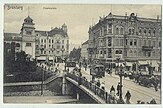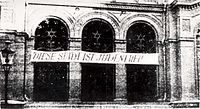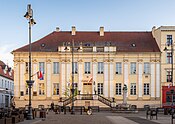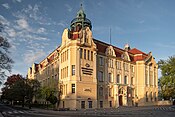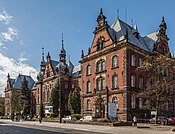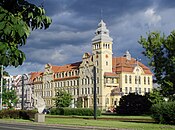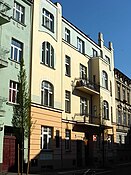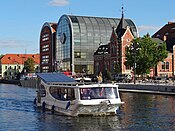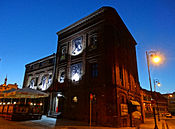Bydgoszcz
Bydgoszcz | |
|---|---|
Downtown withFreedom Square Banks of theBrdaRiver in the Old Town | |
| Nickname: | |
| Coordinates:53°7′19″N18°00′01″E/ 53.12194°N 18.00028°E | |
| Country | |
| Voivodeship | Kuyavian-Pomeranian |
| County | city county |
| Established | before 1238 |
| City rights | 1346 |
| Government | |
| •City mayor | Rafał Bruski(PO) |
| •City Council Chairperson | Monika Matowska (PO) |
| Area | |
| • Total | 176 km2(68 sq mi) |
| Elevation | 60 m (200 ft) |
| Population (31 December 2022) | |
| • Total | 330,038 |
| • Density | 1,875/km2(4,860/sq mi) |
| GDP | |
| • Bydgoszcz–Toruń metropolitan area | €10.871 billion (2020) |
| Time zone | UTC+1(CET) |
| • Summer (DST) | UTC+2(CEST) |
| Postal code | 85-001 to 85–915 |
| Area code | (+48) 52 |
| Car plates | CB |
| Primary airport | Bydgoszcz Ignacy Jan Paderewski Airport |
| Highways | |
| Website | www |
Bydgoszcz[a]is a city in northernPolandand the largest city in the historical region ofKuyavia.Straddling the confluence of theVistula Riverand itsleft-banktributary, theBrda,the strategic location of Bydgoszcz has made it an inland port and a vital centre for trade and transportation. With a city population of 339,053 as of December 2021,[5]Bydgoszcz is the eighth-largest city in Poland. Today, it is the seat ofBydgoszcz Countyand one of the two capitals of theKuyavian-Pomeranian Voivodeshipas a seat of its centrally appointed governor, avoivode.
Bydgoszcz metropolitan areacomprising the city and several adjacent communities is inhabited by half a million people, and forms a part of an extended polycentricBydgoszcz-Toruń metropolitan areawith the population of approximately 0.8 million inhabitants. Since the Middle Ages, Bydgoszcz served as aroyal cityofthe Crown of the Kingdom of Polanduntilpartitionsand experienced the industrialisation period bolstered by the construction of theBydgoszcz Canalin the late 18th century. Its academic and cultural landscape is shaped byCasimir the Great University,Bydgoszcz University of Science and Technology,the Medical College ofNicolaus Copernicus University,Feliks Nowowiejski Music Academy,thePomeranian Philharmonic,and theOpera Nova.Bydgoszcz also plays a role of the biggest centre ofNATOheadquarters in Poland.[13][14]The city is served by aninternational airportand is a member ofEurocities.
Bydgoszcz is an architecturally rich city, withgothic,neo-gothic,neo-baroque,neoclassicist,modernistandArt Nouveaustyles present, for which, combined with extensive green spaces, it has earned the nicknameLittle Berlin.[1]The notable granaries onMill Islandand along the riverside belong to one of the most recognizedtimber-framedlandmarks in Poland.[15]In 2023, the city entered theUNESCOCreative Cities Networkand was named UNESCOCity of Music.[16]
Etymology
[edit]The nameBydgoszcz,originallyBydgoszcza,derives fromBydgost,a personal name, and the suffix -ja,denoting ownership. The German nameBrombergis an alteration ofBraheberg,meaning "hill on the Brahe River" (Polish:Brda).[17]TheLatinnames for the city isBidgostiaandCivitas Bidgostiensis.
InPolish,the city's name has feminine grammatical gender.
History
[edit]Early history and first settlements
[edit]
Inancienttimes, there was a development of settlements related to lively trade contacts with theRoman Empire,as a convenient location of today's Bydgoszcz laid on theAmber Roadheading northwest to the Baltic coastline avoiding crossing the Vistula river.[18][19][20]
During theearly Slavicperiod a fishing settlement calledBydgoszcza( "Bydgostia" in Latin) became a stronghold on the Vistulatrade routes.
Thegródof Bydgoszcz was built between 1037 and 1053 during the reign ofCasimir I the Restorer.In the 13th century it was the site of acastellany,mentioned in 1238, probably founded in the early 12th century during the reign ofBolesław III Wrymouth.In the 13th century, the church ofSaint Gileswas built as the first church of Bydgoszcz. The Germans later demolished it in the late 19th century.[21][better source needed]The first bridge was constructed at the reign ofCasimir I of Kuyavia.In the early 14th century, theDuchy of Bydgoszcz and Wyszogródwas created, with Bydgoszcz serving as its capital with Wyszogród, a settlement today within its borders.
During thePolish–Teutonic War (1326–1332),the city was captured and destroyed by theTeutonic Knightsin 1330.[21][better source needed]Briefly regained by Poland, it was occupied by the Teutonic Knights from 1331 to 1337 and annexed to theirmonastic stateas[citation needed][dubious–discuss]Bromberg.In 1337, it was recaptured by Poland and was relinquished by the Knights in 1343 at their signing of theTreaty of Kaliszalong withDobrzyńand the remainder ofKuyavia.
Royal city of Poland
[edit]KingCasimir III of Polandgranted Bydgoszczcity rights(charter) on 19 April 1346.[22]The king granted a number of privileges, regarding river trade on theBrdaandVistulaand the right to mint coins, and ordered the construction of the castle, which became the seat of the castellan.[23]Bydgoszcz was an importantroyal city of Polandlocated in theInowrocław Voivodeship.
The city increasingly saw an influx ofJewsafter that date.[citation needed]In 1555, however, due to pressure from the clergy, the Jews were expelled[citation needed]and returned only with their annexation toPrussiain 1772.[citation needed]After 1370, Bydgoszcz castle was the favourite residence of the grandson of the king and his would-be successor DukeCasimir IV,who died there in 1377.[23]In 1397 thanks to QueenJadwiga of Poland,aCarmeliteconvent was established in the city, the third in Poland afterGdańskandKraków.[23]
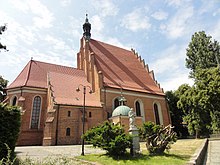
During thePolish–Lithuanian–Teutonic Warin 1409 the city was briefly captured by the Teutonic Knights.[21]In the mid-15th century, during theThirteen Years' War,KingCasimir IV of Polandoften stayed in Bydgoszcz. At that time, the defensive walls were built[21]and theGothicparish church (the present-dayBydgoszcz Cathedral). The city was developing dynamically thanks to river trade. Bydgoszczpotteryand beer were popular throughout Poland. In the 15th and 16th centuries, Bydgoszcz was a significant location forwheattrading, one of the largest in Poland.[21][better source needed]The first mention of a school in Bydgoszcz is from 1466.[21][better source needed]
In 1480, a Bernardine monastery was established in Bydgoszcz.[23]The Bernardines erected a new Gothic church and founded a library, part of which has survived to this day.[23]ASejm of the Kingdom of Polandwas held in Bydgoszcz in 1520.[24]In 1522, after a decision taken by the Polish king, asaltdepot was established in Bydgoszcz, the second in the region[which?]afterToruń.[21][better source needed]In 1594, Stanisław Cikowski founded a privatemint,which in the early 17th century was transformed into a royal mint, one of the leading mints in Poland.[23]
In 1621, on the occasion of the Polish victory over theOttoman EmpireatChocim,one of the most valuable and largest coins in the history of Europe was minted in Bydgoszcz – 100 ducats ofSigismund III Vasa.[23]In 1617 theJesuitscame to the city, and subsequently established a Jesuit college.[21][better source needed]

During the year of 1629, shortly before the end of thePolish-Swedish War of 1626–29,the town was conquered by Swedish troops led by kingGustav II AdolphofSwedenpersonally. During this war, the town suffered destruction.[25]The town was conquered a second and third time by Sweden in 1656 and 1657 during theSecond Northern War.On the latter occasion, the castle was destroyed completely and has since remained a ruin. After the war only 94 houses were inhabited, 103 stood empty and 35 had burned down. The suburbs had also been considerably damaged.[26]
TheTreaty of Bromberg,agreed in 1657 by KingJohn II Casimir VasaofPolandand ElectorFrederick William IIofBrandenburg-Prussia,created a military alliance between Poland and Prussia while marking the withdrawal of Prussia from its alliance with Sweden.
After theConvocation Sejm of 1764,Bydgoszcz became one of three seats of theCrown Tribunalfor theGreater Poland Province of the Polish CrownalongsidePoznańandPiotrków Trybunalski.[21][better source needed]In 1766 royal cartographerFranciszek Florian Czaki,during a meeting of the Committee of the Crown Treasury inWarsaw,proposed a plan of building a canal, which would connect the Vistula via the Brda with theNotećriver.Józef Wybicki,Polish jurist and political activist best known as the author of the lyrics of thenational anthem of Poland,worked at the Crown Tribunal in Bydgoszcz.[27]
Late modern period
[edit]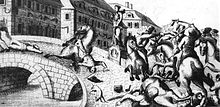
In 1772, in theFirst Partition of Poland,the town was acquired by theKingdom of Prussiaas Bromberg and incorporated into theNetze Districtin the newly established province ofWest Prussia.At the time, the town was seriously depressed and semi-derelict.[28]UnderFrederick the Greatthe town revived, notably with the construction of a canal from Bromberg toNakel(Nakło) which connected the north-flowing Vistula River via the Brda to the west-flowingNoteć,which in turn flowed to theOdervia theWarta.[29]From this period until the end of the German Empire, a large majority of the city's inhabitants spoke German as their main language, and the city woud later acquire the nickname "little Berlin" from its similar architectural appearance to the prewar image of the German capital and the work of shared architects such asFriedrich Adler,Ferdinand Lepcke,Heinrich Seeling,orHenry Gross.[4]During theKościuszko Uprising,in 1794 the city was briefly recaptured by Poles, commanded by GeneralJan Henryk Dąbrowski,[23]and the local Polish administration was co-organized byJózef Wybicki.[27]
In 1807, after the defeat of Prussia byNapoleonand the signing of theTreaty of Tilsit,Bydgoszcz became part of the short-lived PolishDuchy of Warsaw,within which it was the seat of theBydgoszcz Department.With Napoleon's defeat at theBattle of Nationsin 1813, the town was re-annexed by Prussia as part of theGrand Duchy of Posen(Poznań), becoming the capital of theBromberg Region.During theNovember Uprising,aPolish insurgent organizationwas active in the city and local Poles helped smuggle volunteers, weapons and ammunition to theRussian Partitionof Poland.[30]After the fall of the uprising, one of the main escape routes for surviving insurgents and civilian insurgent authorities from partitioned Poland to theGreat Emigrationled through the city.[31]
In 1871 the Province of Posen, along with the rest of the Kingdom of Prussia, became part of the newly formedGerman Empire.During German rule, the oldest church of the city (church of Saint Giles), the remains of the castle,[21][23]and the Carmelite church and monastery were demolished. In the mid-19th century, the city saw the arrival of thePrussian Eastern Railway.The first stretch, from Schneidemühl (Piła), was opened in July 1851.
At the time ofWorld War I,Poles in Bydgoszcz formed secret organizations, preparing to regain control of the city in the event of Poland regaining its independence.[32]
Interbellum
[edit]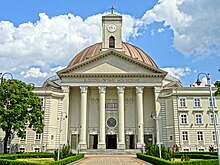
After the war, Bydgoszcz was assigned to therecreated Polish stateby the 1919Versailles Treaty.Now officially Bydgoszcz again, the city belonged to thePoznań Voivodeship.The local populace was required to acquire Polish citizenship or leave the country. This led to a drastic decline in ethnicallyGerman residents,whose number within the town decreased from over 40.000 in 1910 to 11,016 in 1926.[34]A Nazi German youth organization was subsequently founded, which distributedNazi propagandabooks from Germany among the German minority.[35]
The city's boundaries were greatly expanded in 1920 to include the surrounding suburbs of Okole, Szwederowo, Bartodzieje, Kapuściska, Wilczak, Jachcice and more, which made Bydgoszcz the third biggest in terms of size area city of theSecond Polish Republic.[36]In 1938, the city was made part of the PolishGreater Pomerania.
World War II
[edit]
During theinvasion of Poland,at the beginning ofWorld War II,on September 1, 1939, Germany carried out air raids on the city. The Polish15th Infantry Division,which was stationed in Bydgoszcz, fought off German attacks on September 2, but on September 3 was forced to retreat. During the withdrawal of Poles, as part of the diversion planned by Germany, local Germans opened fire on Polish soldiers and civilians. Polish soldiers and civilians were forced into a defensive battle in which several hundred people were killed on both sides. The event, referred to as theBloody Sundayby thepropaganda of Nazi Germany,which exaggerated the number of victims to 5,000 "defenceless" Germans, was used as an excuse to carry out dozens of mass executions of Polish residents in the Old Market Square and in theValley of Death.[21][23]Between September 3–10, 1939, the Germans executed 192 Poles in the city.[37]
On September 5, while theWehrmachtentered the city, German-Polish skirmishes still took place in the Szwederowo district, and theGerman occupationof the city began. The GermanEinsatzgruppe IV,Einsatzkommando 16andSS-Totenkopf-Standarte "Brandenburg" entered the city to commitatrocities against the Polish population,and afterwards some of its members co-formed the local German police.[38]Many of the murders were carried out as part of theIntelligenzaktion,aimed at exterminating the Polish elites and preventing the establishment of aPolish resistance movement,[39]which emerged regardless. On September 24, the local GermanKreisleitercalled local Polish city officials to a supposed formal meeting in the city hall, from where they were taken to a nearby forest and exterminated.[40]TheKreisleiteralso ordered the execution of their family members to "avoid creating martyrs".[40]By decision from September 5, 1939, one of the first three German special courts in occupied Poland was established in Bydgoszcz.[41]
The Germans established several camps and prisons for Poles.[37]As of September 30, 1939, over 3,000 individuals were imprisoned there, and in October and November, the Germans carried out further mass arrests of over 7,200 people.[42]Many of those people were then murdered.[43]Poles from Bydgoszcz were massacred at various locations in the city, at the Valley of Death and in the nearby village ofTryszczyn.[43]The victims were both men and women, including activists, school principals, teachers, priests, local officials, merchants, lawyers, and also boy and girl scouts, gymnasium students and children as young as 12.[44]The executions were presented as punishment for supposedly "murdering Germans" and "destroying peace", and were used by Nazi propaganda to show the world that it was alleged "Polish terror" that forcedHitlerto start the war.[43]On thePolish National Independence Day,November 11, 1939, the Germans symbolically publicly executed Leon Barciszewski, the mayor of Bydgoszcz.[45]On November 17, 1939, the commander of the localSD-EKunit declared there was no more Polishintelligentsiacapable of resistance in the city.[45]
The city was annexed to the newly formed province ofReichsgau Danzig-West Prussiaas theseatof the district or county (kreis) of Bromberg. However, the annexation was not recognised in international law. Extermination of the inhabitants continued throughout the war, and in total, around 10,000 inhabitants, mostlyPoles,but alsoPolish Jews,were killed.[21][better source needed]Some Polish inhabitants were also murdered in the village ofJastrzębiein January 1940, and local teachers were also among Polish teachers murdered in bothMauthausenandDachauconcentration camps.[46]The history ofJewsin Bydgoszcz ended with theGerman invasion of Polandand theHolocaust.The city's Jewish citizens, who constituted a small community in the city (about two percent of the prewar population)[47]and many of whom spoke German, were sent toextermination campsor murdered in the town itself. The city renamedBrombergwas the site ofBromberg-Ost,a women's subcamp of theStutthof concentration camp.A deportation camp was situated in Smukała village, now part of Bydgoszcz. On February 4, 1941, the first mass transport of 524 Poles came to thePotulice concentration campfrom Bydgoszcz.[48]The local train station was one of the locations, where Polish children aged 12 and over were sent from the Potulice concentration camp to slave labor.[49]The children reloaded freight trains.[49]
During theoccupation,the Germans destroyed some of the city's historic buildings to erect new structures in theNazi style.[23]The Germans built a huge secret dynamite factory (DAG Fabrik Bromberg) hidden in a forest in which they used theslave laborof several hundred forced laborers,[23]includingAlliedprisoners of warfrom theStalag XX-APOW camp in Toruń.[50]In 1943, local Poles managed to save somekidnapped Polish childrenfrom theZamośćregion, by buying them from the Germans at the local train station.[51]
The Polish resistance was active in Bydgoszcz. Activities included distribution of underground Polish press, sabotage actions, stealing German ammunition to aid Polish partisans, espionage of German activity[52]and providing shelter for British POWs who escaped from the Stalag XX-A POW camp.[53]TheGestapocracked down on the Polish resistance several times.[54]
In spring 1945, Bydgoszcz was occupied by the advancingRed Army.Those German residents who had survived wereexpelledin accordance with thePotsdam Agreementand the city was returned to Poland, although with a Soviet-installed communist regime, which stayed in power until the 1980s. The Polish resistance remained active in Bydgoszcz.[55]
Post-war period
[edit]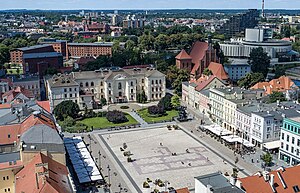
In the same year 1945, the city was made the seat of thePomeranian Voivodship,the northern part of which was soon separated to formGdańsk Voivodship.The remaining part of the Pomeranian Voivodship was renamedBydgoszcz Voivodeshipin 1950. In 1951 and 1969,Bydgoszcz University of Science and TechnologyandKazimierz Wielki University in Bydgoszczwere founded respectively.
In 1973, the former town ofFordon,located on the left bank of the Vistula, was included in the city limits[47]and became the easternmost district of Bydgoszcz. In March 1981,Solidarity's activistswere violently suppressed in Bydgoszcz.
With thePolish local government reformsof 1999, Bydgoszcz became the seat of the governor of a province entitledKuyavian-Pomeranian Voivodeship.In 2005,Casimir the Great Universitywas opened in Bydgoszcz.
Currently, Bydgoszcz is the biggest center ofNATOheadquarters in Poland, the most known being theJoint Force Training Centre.In May 2023, debris of a RussianKh-55air-sol missilewas found in the forest of the near villageZamość.[56]
Main sights
[edit]The oldest building in the city is theCathedral of St Martin and St Nicolas,commonly known as Fara Church. It is a three-aisle late Gothic church, erected between 1466 and 1502, which boasts a late-Gothic painting entitledMadonna with a Roseorthe Holy Virgin of Beautiful Lovefrom the 16th century. The colourful 20th-century polychrome is also especially worthy of note.

TheChurch of the Assumption of the Holy Virgin,commonly referred to as "The Church ofPoor Clares,"is a famous landmark of the city. It is a small, Gothic-Renaissance (includingNeo-Renaissanceadditions), single-aisle church built between 1582 and 1602. The interior is rather austere since the church has been stripped of most of its furnishings. This is not a surprising fact, considering that in the 19th century the Prussian authorities dissolved theOrder of St Clareand turned the church into a warehouse, among other uses. Nonetheless, the church is worth visiting. In particular, the original wooden polychrome ceiling dating from the 17th century draws the attention of every visitor.
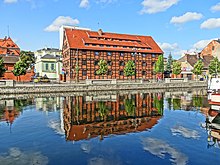
Wyspa Młyńska(Mill Island) is among the most spectacular and atmospheric places in Bydgoszcz. What makes it unique is the location in the very heart of the city centre, just a few steps from the old Market Square. It was the 'industrial' centre of Bydgoszcz in the Middle Ages and for several hundred years thereafter, and it was here that the famous royal mint operated in the 17th century. Most of the buildings which can still be seen on the island date from the 19th century, but the so-calledBiały Spichlerz(the White Granary) recalls the end of the 18th century. However, it is the water, footbridges, historic red-brick tenement houses reflected in the rivers, and the greenery, including old chestnut trees, that create the unique atmosphere of the island.
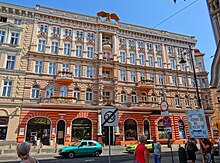
"Hotel pod Orłem"(The Eagle Hotel), an icon of the city's 19th-century architecture, was designed by the distinguished Bydgoszcz architect Józef Święcicki, the author of around sixty buildings in the city. Completed in 1896, it served as a hotel from the very beginning and was originally owned by Emil Bernhardt, a hotel manager educated in Switzerland. Its façade displays forms characteristic of the Neo-baroque style in architecture.
Saint Vincent de Paul's Basilica,erected between 1925 and 1939, is the largest church in Bydgoszcz and one of the biggest in Poland. It can accommodate around 12,000 people. This monumental church, modeled after thePantheonin Rome, was designed by the Polish architect Adam Ballenstaedt. The most characteristic element of the neo-classical temple is the reinforced concrete dome 40 metres in diameter.
Thethree granariesinGrodzka Street,picturesquely located on the Brda River near the old Market Square, are the official symbol of the city. Built at the turn of the 19th century, they were originally used to store grain and similar products, but now house exhibitions of the city's Leon Wyczółkowski District Museum.
The building of the formerPrussian Eastern Railway Headquarterserected between 1886 and 1889 in Dutch Mannierist style is another notable structure in the city. Initially it served as a headquarters of the Prussian Eastern Railway and later it belonged to the Polish State Railways. Since 2022 it is privately owned.
The city is mostly associated with water, sports,Art Nouveaubuildings, waterfront, music, and urban greenery. Bydgoszcz boasts the largest city park in Poland (830 ha). The city was also once famous for its industry.
Some great monuments have been destroyed, for example, the church in the Old Market Square and theMunicipal Theatre.Additionally, the Old Town lost a few characteristic tenement houses, including the western frontage of the Market Square. The city also lost its Gothic castle and defensive walls. In Bydgoszcz, there are a great number of villas in the style of typicalgarden suburbs.

Economy and demographics
[edit]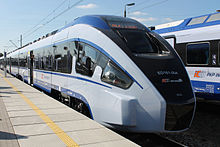
In the city, there are 38 banks represented through a network of 116 branches (including the headquarters of theBank Pocztowy SA), whilst 37 insurance companies also have offices in the city.JP Morgan Chase,one of the largest financial institutions in the world, has established a branch in Bydgoszcz. Most industrial complexes are scattered throughout the city, however, the'Zachem' chemical worksdeserve attention, covering tens of square kilometers in the south-east of the city, the remnants of the German explosives factory built in World War II occupy an area which has its own rail lines, internal communication, housing, and large forested area. theopen-air museum,Exploseum,was built on its base.
Since 2001, Bydgoszcz has been annually subjected to international 'verification' ratings. In February 2008 the Agency 'Fitch Ratings', recategorised the city, increasing its rating from BBB-(stable forecast) to BBB (stable estimate).
In 2004, Bydgoszcz launched an Industrial and Technology Park of 283 hectares, an attractive place for doing business as companies that relocate there receive tax breaks, 24-hour security, access to large plots of land and to the media, the railway line Chorzów Batory – Tczew (passenger, coal), the DK5 and DK10 national roads, and future freewaysS10andS5.Bydgoszcz Airport is also close by.
Population growth since 17th century
[edit]
Culture
[edit]
Bydgoszcz is a major cultural centre in the country, especially for music. Traditions of the municipal theatre date back to the 17th century, when the Jesuit college built a theatre. In 1824, apermanent theatre buildingwas erected, and this was rebuilt in 1895 in a monumental form by the Berlin architect Heinrich Seeling. The first music school was established in Bydgoszcz in 1904; it had close links to the very well-known European piano factory of Bruno Sommerfeld. Numerous orchestras and choirs, both German (Gesangverein, Liedertafel) and Polish (St. Wojciech Halka, Moniuszko), have also made the city their home. Since 1974, Bydgoszcz has been home to a very prestigiousAcademy of Music.Bydgoszcz is also an important place for contemporary European culture; one of the most important European centers of jazz music, the Brain club, was founded in Bydgoszcz by Jacek Majewski and Slawomir Janicki.
Bydgoszcz was a candidate for the title ofEuropean Capital of Culturein 2016. [57]It joined the list ofUNESCO'sCities of Musicin 2023.[58]
Museums
[edit]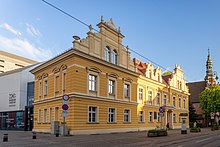
Muzeum Okręgowe im. Leona Wyczółkowskiego (Leon Wyczółkowski District Museum) is a municipally-owned museum. Apart from a large collection ofLeon Wyczółkowski's works, it houses permanent as well as temporary exhibitions of art. It is based in several buildings, including the old granaries on theBrdaRiver andMill Islandand the remaining building of the Polish royal mint.Exploseum,a museum built around theWorld War IINazi Germanymunitions factory, is also part of it.
In Bydgoszcz, thePomeranian Military Museumspecializes in documenting 19th- and 20th-century Polish military history, particularly the history of the Pomeranian Military District and several other units present in the area.
The city has many art galleries, twosymphony orchestras,many chamber orchestras and choirs. Bydgoszcz's cultural facilities also include libraries, including theProvincial and Municipal Public Librarywith an extensive collection of volumes from the 15th to the 19th centuries. The municipally-ownedPalaces and park ensemble in Ostromeckonear the city contains theAndrzej SzwalbeCollection of Historical Pianos, one of the largest such collections in Poland.
Classical music
[edit]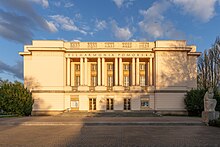
- The Pomeranian Philharmonic performance home with full nameFilharmonia Pomorska im. Ignacego Paderewskiego(Ignacy Paderewski's [Concert Hall]) includes its 880-seat main hall, theArthur RubinsteinHall, a key European, rectangular, concert hall with superb acoustic qualities, still mainly hosting all types ofclassical music.
Popular music
[edit]- Concerts ofpopular musicin Bydgoszcz are usually held in Filharmonia Pomorska,Łuczniczka,Zawisza and Polonia stadiums as well asopen plainsof Myslecinek's Rozopole on the outskirts of the city.
- Alternative musicfestival "Low Fi"[1]Archived2015-11-21 at theWayback Machine
- Smooth Festival Złote Przeboje Bydgoszcz
- Eska Music Festival Bydgoszcz
- Hity na Czasie Festival Bydgoszcz
- Bydgoszcz Hit Festival
Theatre
[edit]
Teatr Polski im Hieronima Konieczki(Hieronim Konieczka's Polish Theatre): Despite its name, the theatre offers a wide variety of shows both of national and foreign origin. It also regularly plays host to a large number of touring shows. Founded in 1949, since 2002 the theatre has taken part in the "Festiwal Prapremier" where the most renowned Polish theatres stage their latest works. There are also a number of private theatre companies operating in Bydgoszcz.
From 1960 to 1986, there was an outdoor theater, the reactivation of which is currently being pursued by the Theatre Culture Association, "Fides" and the Acting School A. Grzymala-Siedlecki.

ThePomeranian Philharmonicnamed afterIgnacy Jan Paderewskihas existed since 1953. The concert hall, which can hold 920 people is classified, in terms of sound, as one of the best in Europe, which is confirmed by well-known artists and critics (includingJerzy Waldorff). Due to the phenomenon of acoustics, it attracts the interest of many famous artists. Bydgoszcz's stage has been frequented by many global celebrities, includingArthur Rubinstein,Benjamin Britten,Witold Małcużyński,Luciano Pavarotti,Shlomo Mintz,Mischa Maisky,Kevin Kenner,Kurt Masur,Kazimierz Kord,Jerzy MaksymiukandAntoni Wit.In recent years, the city has also hosted an excellent range of bands such as the BBC Radio Symphony Orchestra, thePolish National Radio Symphony Orchestra,and others.
TheOpera Nova,in existence since 1956, started the construction of a new building in 1974 which was to consist of three main halls, situated on the Brda. The Opera Nova has become a cultural showcase of Bydgoszcz in the world. Considering the short history of the Opera, its success has been astounding; a large number of famous opera singers have performed there and theatrical troops from the Wrocław Opera, Theatre of Leningrad, Moscow, Kiev, Minsk, and Gulbenkian Foundation of Lisbon have also made appearances.
Cinematography
[edit]- The International Film Festival of the Art of CinematographyCAMERIMAGEis a festival dedicated tocinematographyand its creatorscinematographers.
Education
[edit]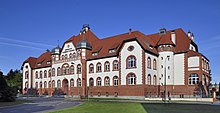
|
|
|
Transport
[edit]Airports
[edit]Railways
[edit]Bydgoszcz is one of the biggest railway junctions in Poland, with two important lines crossing there – the east–west connection fromToruńtoPilaand the north–south line fromInowrocławtoGdańsk(see:Polish Coal Trunk-Line). There are also secondary-importance lines stemming from the city, toSzubinand toChełmża.Among rail stations located in the city, there are:
|
|
Buses and trams
[edit]- Local buses andtramsare operated byZDMiKP Bydgoszcz
- PKS Bydgoszcz – operates inter-city and international bus routes.
-
Historic main railway station in Bydgoszcz
-
Modern part of the main railway station
-
Tram in Bydgoszcz
Sports
[edit]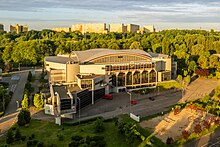

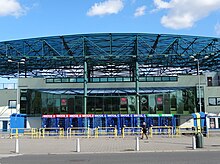
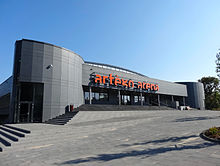

Sports clubs
[edit]- Basket 25 Bydgoszcz– women's basketball team playing inBasket Liga Kobiet,the country's top division.
- Astoria Bydgoszcz– men'sbasketballteam playing inPolish Basketball League,the country's top division (as of2022–23).
- Bydgoszcz Archers– American football team playing inPolish Football League,the country's top division.
- Pałac Bydgoszcz– women's volleyball team playing inPolish Women's Volleyball League,the country's top division.
- BKS Visła Bydgoszcz– men'svolleyballteam playing inPolish Volleyball League,the country's top division.
- KKP Bydgoszcz– women's football team playing inEkstraliga,the country's top division.
- Chemik Bydgoszcz– men's football team playing in the country's lower league.
- Polonia Bydgoszcz–speedwayteam, seven-timePolish League champions(lately in 2002) and three-timeEuropean Speedway Club Champions'(lately in 2001) and football team, which played in thetop tierin the 1950s and 1960s.
- Zawisza Bydgoszcz–footballteam, which played in the past in thecountry's top flight,most recently in 2015, currently playing in the lower league.
- RTW Bydgostia Bydgoszcz–Rowing (sport)Bydgostia Regional Rowing Association was founded on 4 December 1928. The club was A Team Polish Champion in the following years: 1938, 1966, 1967, 1970 and for the successive seventeen years from 1993 to 2009.
- Gwiazda Bydgoszcz– men'stable tennisteam playing in Superliga, the country's top division. The club is also successfully competing in table tennisEurope Cup.
Sports facilities
[edit]- Łuczniczka,Show and Fair Arena
- Sisu Arena,a closed indoor arena
- Zdzisław Krzyszkowiak Stadium
- Polonia Stadium
- Hala Torbyd,a closed indoor arena
Sports events
[edit]- Athletics
- 2003 European Athletics U23 Championships
- 2008 World Junior Championships in Athletics
- 2010 IAAF World Cross Country Championships
- 2013 IAAF World Cross Country Championships
- 2016 World Junior Championships in Athletics
- 2017 European Athletics U23 Championships
- 2019 European Team Championships
- European Athletics Festival Bydgoszcz(annual event part of the EuropeanPermit Meetingscircuit)
- Speedway
- Grand Prix of Poland:(1998–1999, 2001–2009)
- Grand Prix of Europe:(2000)
- Mieczysław Połukard Criterium of Polish Speedway Leagues Aces(1951–1960, since 1982)
- Team sports
Politics
[edit]Bydgoszcz constituency
[edit]Members of Polish Sejm 2007–2011elected from Bydgoszcz constituency:
|
|
|
Members ofPolish Senate2007–2011elected from Bydgoszcz constituency:
- Zbigniew Pawłowicz, Civic Platform
- Jan Rulewski,Civic Platform
International relations
[edit]
Twin towns and friendship relations
[edit]
| Twin Towns | ||
| City/Town | Country | Year |
|---|---|---|
| Reggio Emilia | 12.04.1962 | |
| Kragujevac[60] | 23.07.1971 | |
| Mannheim[61] | 26.11.1991 | |
| Hartford | 30.09.1996 | |
| Pavlodar | 10.04.1997 | |
| Perth | 9.05.1998 | |
| Cherkasy | 13.09.2000 | |
| Kremenchuk | 30.06.2004 | |
| Patras | 8.10.2004[63] | |
| Ningbo | 28.12.2005 | |
| Wilhelmshaven | 19.04.2006 | |
| Pitești | 22.06.2007[64][65] | |
| Sliven | 9.09.2019 | |
Legends
[edit]It is said thatPan Twardowskispent some time in the city of Bydgoszcz, where, in his memory, a figure was recently mounted in a window of a tenement, overseeing the Old Town. At 1:13 p.m. and 9:13 p.m. the window opens and Pan Twardowski appears, to the accompaniment of weird music and devilish laughter. He takes a bow, waves his hand, and then disappears. This little show gathers crowds of amused spectators.
Gallery
[edit]-
Main Libraryon the Old Market Square
-
Ralph ModjeskiBridge inFordon District
-
Former headquarters of the
Prussian Eastern Railway -
Former Jesuit College (1617), now City Hall
-
Bydgoszcz Cathedral's façade
-
Bydgoszcz Scientific Society
-
Birthplace ofMarian Rejewski
-
BrdaRiver in the city centre
-
Former Polish Royal mint, now a museum
-
Sluice gate onBydgoszcz Canal
-
The district court building
-
Czerwony Spichlerz - Museum of Contemporary Art in Bydgoszcz
-
School of Fine Arts
-
Music Club Eljazz
-
Nordic Haven apartment block
-
Bernardine church
-
The University Bridge
-
Statue ofJohn of Nepomuk
-
The White Granary, seat of the Archeological Museum in Bydgoszcz
Climate
[edit]Bydgoszcz has ahumid continental climate(KöppenDfb).
| Climate data for Bydgoszcz (1991–2020 normals, extremes 1951–1982 and 1992–2015) | |||||||||||||
|---|---|---|---|---|---|---|---|---|---|---|---|---|---|
| Month | Jan | Feb | Mar | Apr | May | Jun | Jul | Aug | Sep | Oct | Nov | Dec | Year |
| Record high °C (°F) | 13.0 (55.4) |
14.1 (57.4) |
22.8 (73.0) |
30.7 (87.3) |
31.9 (89.4) |
35.5 (95.9) |
38.3 (100.9) |
37.0 (98.6) |
33.4 (92.1) |
28.2 (82.8) |
19.5 (67.1) |
15.9 (60.6) |
38.3 (100.9) |
| Mean maximum °C (°F) | 8.2 (46.8) |
9.4 (48.9) |
15.7 (60.3) |
23.3 (73.9) |
27.5 (81.5) |
30.6 (87.1) |
31.7 (89.1) |
31.1 (88.0) |
25.5 (77.9) |
20.0 (68.0) |
13.1 (55.6) |
8.8 (47.8) |
33.1 (91.6) |
| Mean daily maximum °C (°F) | 1.1 (34.0) |
2.7 (36.9) |
6.9 (44.4) |
14.1 (57.4) |
19.4 (66.9) |
22.1 (71.8) |
24.6 (76.3) |
23.9 (75.0) |
18.6 (65.5) |
12.7 (54.9) |
6.2 (43.2) |
2.0 (35.6) |
12.9 (55.2) |
| Daily mean °C (°F) | −1.5 (29.3) |
−0.4 (31.3) |
2.5 (36.5) |
8.5 (47.3) |
13.7 (56.7) |
16.7 (62.1) |
19.1 (66.4) |
18.2 (64.8) |
13.3 (55.9) |
8.2 (46.8) |
3.5 (38.3) |
−0.3 (31.5) |
8.5 (47.2) |
| Mean daily minimum °C (°F) | −3.7 (25.3) |
−3.0 (26.6) |
−0.8 (30.6) |
3.5 (38.3) |
8.1 (46.6) |
11.2 (52.2) |
13.7 (56.7) |
13.1 (55.6) |
9.3 (48.7) |
5.1 (41.2) |
1.3 (34.3) |
−2.4 (27.7) |
4.6 (40.3) |
| Mean minimum °C (°F) | −14.9 (5.2) |
−12.4 (9.7) |
−8.3 (17.1) |
−3.1 (26.4) |
0.9 (33.6) |
5.6 (42.1) |
8.8 (47.8) |
7.6 (45.7) |
2.7 (36.9) |
−2.3 (27.9) |
−5.9 (21.4) |
−11.7 (10.9) |
−18.3 (−0.9) |
| Record low °C (°F) | −29.9 (−21.8) |
−26.6 (−15.9) |
−25.4 (−13.7) |
−8.5 (16.7) |
−5.1 (22.8) |
−1.8 (28.8) |
2.5 (36.5) |
1.9 (35.4) |
−4.0 (24.8) |
−8.3 (17.1) |
−19.6 (−3.3) |
−24.2 (−11.6) |
−29.9 (−21.8) |
| Averageprecipitationmm (inches) | 34.3 (1.35) |
26.3 (1.04) |
36.4 (1.43) |
28.2 (1.11) |
52.8 (2.08) |
56.7 (2.23) |
83.4 (3.28) |
55.6 (2.19) |
48.0 (1.89) |
40.1 (1.58) |
33.6 (1.32) |
36.9 (1.45) |
532.3 (20.95) |
| Average precipitation days(≥ 0.1 mm) | 16.0 | 13.4 | 12.9 | 10.5 | 12.4 | 12.4 | 14.2 | 12.0 | 10.9 | 12.7 | 13.7 | 16.9 | 158.4 |
| Averagerelative humidity(%) | 86.8 | 86.6 | 81.4 | 71.5 | 69.7 | 71.1 | 73.6 | 75.4 | 81.7 | 86.3 | 90.5 | 89.3 | 80.3 |
| Averagedew point°C (°F) | −4 (25) |
−3 (27) |
−1 (30) |
2 (36) |
7 (45) |
10 (50) |
13 (55) |
13 (55) |
10 (50) |
6 (43) |
3 (37) |
−1 (30) |
5 (40) |
| Source 1: Meteomodel.pl[66][67] | |||||||||||||
| Source 2: Time and Date (dewpoints, 2005-2015)[68] | |||||||||||||
People born in Bydgoszcz
[edit]
|
|
|
See also
[edit]- Bydgoszcz Architects (1850-1970s)
- Gdańska Street
- Dworcowa Street
- Theatre square
- Mill Island
- Freedom Square
- Grodzka Street
- Nakielska street
- Cieszkowskiego Street
- Independence Estate (Bydgoszcz)
- Jagiellońska street
- Stary Port Street
- Bernardyńska Street
- Podwale Street
- Długa street
- Adam Mickiewicz Alley
- Ossoliński Alley
- Śniadeckich Street
- Pomorska Street
- Focha Street
- Krasińskiego Street
- Bydgoszcz Synagogue,former synagogue in the city
- Roman Catholic Diocese of Bydgoszcz
- Piastowski Square
- Konarskiego Street
- Piotra Skargi Street
- Kołłątaja street in Bydgoszcz
- Gimnazjalna, Libelta and Szwalbego Streets
- Mikołaja Reja Street
- Swiętej Trojcy street
- Kopernika Street
- Krakowska Street
- Osowa Góra
- Flisy (Bydgoszcz district)
- Glinki (Bydgoszcz district)
Notes
[edit]- ^
- Pronunciation:
- British English:/ˈbɪdɡɒʃtʃ/BID-goshtch[7]
- American English:US:/-ɡɔːʃ(tʃ)/-gawsh(tch)[8][9][10]
- Polish:Polish pronunciation:[ˈbɨdɡɔʂt͡ʂ]
- German:Bromberg,pronounced[ˈbʁɔmˌbɛʁk]
- Latin:Bidgostia/Bydgostia,[11]Brombergum[12]
- Yiddish:בידגאש,romanized:Bidgash
- Pronunciation:
References
[edit]- ^abTeam, 3W Design."Camerimage – International Film Festival".camerimage.pl.Archived fromthe originalon 2017-08-03.Retrieved16 May2017.
{{cite web}}:CS1 maint: numeric names: authors list (link) - ^"Bydgoszcz as" Klein Berlin "".visitbydgoszcz.pl.Retrieved24 February2024.
- ^"ul. Cieszkowskiego, Bydgoszcz".inyourpocket.Retrieved24 February2024.
- ^ab"Berlin i" klein Berlin "na jednej pocztówce. Dzieła tych samych architektów w Niemczech i Bydgoszczy".wyborcza.pl.Retrieved24 February2024.
- ^ab"Local Data Bank".Statistics Poland.Retrieved2022-06-02.Data for territorial unit 0461011.
- ^"Gross domestic product (GDP) at current market prices by NUTS 3 regions".ec.europa.eu.
- ^"Bydgoszcz".LexicoUK English Dictionary.Oxford University Press.Archived fromthe originalon 2020-07-27.
- ^"Bydgoszcz".The American Heritage Dictionary of the English Language(5th ed.). HarperCollins.Retrieved18 August2019.
- ^"Bydgoszcz".Collins English Dictionary.HarperCollins.Retrieved18 August2019.
- ^"Bydgoszcz".Merriam-Webster Dictionary.Retrieved18 August2019.
- ^Wiesław Wydra,Chrestomatia staropolska. Teksty do roku 1543.Wrocław. Ossolineum. 1984. ISBN 83-04-01568-4.
- ^Brombergumattested e.g. in: [Anon.]: Geographica Globi Terraquei Synopsis [...].Trnava1745, p. 278; Laur. Mizlerus de Kolof: Historiarum Poloniae et Magni Ducatus Lithuaniae Scriptorum [...] Collectio Magna [...]. Vol. 2. Warsaw 1769, p. 456; Fran. Math. Stan. Val. Hoefft: De Sanguinis Transfusione. Ph.D. thesis, Berlin 1819, p. 47.
- ^"Bydgoszcz - Polska stolica NATO".miasta.pl(in Polish).Retrieved1 July2024.
- ^"Bydgoszcz umacnia swą pozycję w strukturach NATO".bydgoszcz.pl(in Polish).Retrieved1 July2024.
- ^"Granaries on the Brda – Bydgoszcz, Official Tourism Website, visitbydgoszcz.pl".visitbydgoszcz.pl.Retrieved16 May2017.
- ^"55 new cities join the UNESCO Creative Cities Network on World Cities Day".unesco.org.Retrieved25 February2024.
- ^Niemeyer, Manfred, ed. (2012).Deutsches Ortsnamenbuch.Berlin: De Gruyter. p. 94.ISBN978-3-11-025802-8.
- ^Ptolemy (150)."Photo Gallery: Ptolemy's Geography".The Mirror - International.RetrievedJune 10,2020.
- ^Dygaszewicz, Elżbieta (2000)."From Paleolithic to the Middle Ages".Bydgoszcz Calendar.Bydgoszcz: Society for the Lovers of Bydgoszcz City.ISSN0209-3081.OCLC1150533527.
- ^*Wilke, Gerard (1991–2015). "Prehistory and Early Middle Ages in the Light of Archaeological Sources (until the Beginning of the 12th Century)". In Biskup, Marian; Naukowe, Bydgoskie Towarzystwo (eds.).History of Bydgoszcz.Vol. I. Warsaw: State Publishing House, Sciences.ISBN8301066660.OCLC27641385.
- ^abcdefghijkl"Historia Bydgoszczy".Bydgoski Serwis Turystyczny(in Polish).Retrieved27 October2019.
- ^Heinrich Gottfried Philipp Gengler:Regesten und Urkunden zur Verfassungs- und Rechtsgeschichte der deutschen Städte im Mittelalter.Volume I, Enke, Erlangen 1863,pp. 403–404andpp. 976–977.
- ^abcdefghijkl"Historia Bydgoszczy".VisitBydgoszcz.pl(in Polish).Retrieved27 October2019.
- ^Konopczyński, Władysław (1948).Chronologia sejmów polskich 1493–1793(in Polish). Kraków:Polska Akademia Umiejętności.p. 135.
- ^Ludwig Kühnast:Historische Nachrichten über die Stadt Bromberg – Von der Gründung der Stadt bis zur preußischen Besitznahme.Bromberg Berlin Posen 1837,pp 64–68.
- ^Ludwig Kühnast (1837),pp. 112–117.
- ^abKrzysztof Drozdowski."Rocznica śmierci Józefa Wybickiego. Razem z generałem Dąbrowskim wyzwalał Bydgoszcz".Tygodnik Bydgoski(in Polish).Retrieved7 September2021.
- ^August Eduard Preuß:Preußische Landes- und Volkskunde.Königsberg 1835,p. 381.
- ^Baedeker, Karl,Northern Germany,London, 1904, p.163.
- ^Umiński, Janusz (1998). "Losy internowanych na Pomorzu żołnierzy powstania listopadowego".Jantarowe Szlaki(in Polish). Vol. 4, no. 250. p. 13.
- ^Umiński, p. 16
- ^Stefan Pastuszewski."Bydgoszcz w ręce polskie przeszła pokojowo".Tygodnik Bydgoski(in Polish).Retrieved27 October2019.
- ^"Bydgoszcz niepodległa. Kadry, przedmioty i gmachy XX-lecia".Gazeta Wyborcza(in Polish).Retrieved25 February2024.
- ^Kotowski, Albert S. (1998).Polens Politik gegenüber seiner deutschen Minderheit 1919–1939(in German). Forschungsstelle Ostmitteleuropa,University of Dortmund.p. 56.ISBN3-447-03997-3.
- ^Wardzyńska 2009,p. 23.
- ^Infrastruktura i gospodarka komunalna.Historia Bydgoszczy.Tom II. Część druga 1920-1939: red. Marian Biskup: Bydgoszcz: Bydgoskie Towarzystwo Naukowe 2004. s. 233–249,ISBN83-921454-0-2
- ^abWardzyńska 2009,p. 110.
- ^Wardzyńska 2009,pp. 55, 61–62.
- ^Wardzyńska 2009,p. 71.
- ^abWardzyńska 2009,p. 102.
- ^Grabowski, Waldemar (2009). "Polacy na ziemiach II RP włączonych do III Rzeszy".Biuletyn Instytutu Pamięci Narodowej(in Polish). No. 8–9 (103–104). IPN. p. 62.ISSN1641-9561.
- ^Wardzyńska 2009,pp. 157–158.
- ^abcWardzyńska 2009,p. 158.
- ^Wardzyńska 2009,pp. 158–160.
- ^abWardzyńska 2009,p. 160.
- ^Wardzyńska 2009,pp. 180–182.
- ^ab"Encyklopedia PWN".Encyklopedia.pwn.pl. Archived fromthe originalon March 24, 2005.Retrieved2009-05-05.
- ^Molesztak, Aldona (2020). "Doświadczenia obozowe dzieci w niemieckim obozie przesiedleńczym i pracy w Potulicach i Smukale - wspomnienia więźniarek". In Kostkiewicz, Janina (ed.).Zbrodnia bez kary... Eksterminacja i cierpienie polskich dzieci pod okupacją niemiecką (1939–1945)(in Polish).Kraków:Uniwersytet Jagielloński,Biblioteka Jagiellońska.p. 193.
- ^abPaczoska, Alicja (2003). "Dzieci Potulic".Biuletyn Instytutu Pamięci Narodowej(in Polish). No. 12–1 (35–36). IPN. p. 61.ISSN1641-9561.
- ^Bukowska, Hanna (2013). "Obóz jeniecki Stalag XXA w Toruniu 1939-1945".Rocznik Toruński(in Polish). Vol. 40. Towarzystwo Miłośników Torunia,Wydawnictwo Naukowe Uniwersytetu Mikołaja Kopernika.p. 107.ISSN0557-2177.
- ^Kozaczyńska, Beata (2020). "Gdy zabrakło łez... Tragizm losu polskich dzieci wysiedlonych z Zamojszczyzny (1942-1943)". In Kostkiewicz, Janina (ed.).Zbrodnia bez kary... Eksterminacja i cierpienie polskich dzieci pod okupacją niemiecką (1939–1945)(in Polish). Kraków: Uniwersytet Jagielloński, Biblioteka Jagiellońska. p. 123.
- ^Chrzanowski 2022,pp. 30, 40–41, 47–48, 57, 62.
- ^Chrzanowski, Bogdan. "Organizacja sieci przerzutów drogą morską z Polski do Szwecji w latach okupacji hitlerowskiej (1939–1945)".Stutthof. Zeszyty Muzeum(in Polish).5:30, 33–34.ISSN0137-5377.
- ^Chrzanowski 2022,p. 39.
- ^Chrzanowski 2022,p. 74.
- ^"Military object found in Polish forest was Russian missile - media".Reuters.2023-05-10.Retrieved2023-05-31.
- ^City of Bydgoszcz Municipal website
- ^"55 new cities join the UNESCO Creative Cities Network on World Cities Day".Retrieved31 October2023.
- ^WSB University in ToruńArchived2016-03-01 at theWayback Machine– WSB Universities
- ^"Kragujevac Twin Cities".©2009 Information service of Kragujevac City. Archived fromthe originalon 2010-03-10.Retrieved2009-02-21.
- ^"Partner und Freundesstädte".Stadt Mannheim(in German).Retrieved2013-07-26.
- ^"Miasta partnerskie".City of Bydgoszcz(in Polish). 18 October 2007.Retrieved22 August2015.
Perth, Szkocja
- ^"Διεθνείς Σχέσεις".e-patras.gr. Archived fromthe originalon 2012-07-30.Retrieved2011-09-16.
- ^"Twinning Agreement".Bydgoszcz City Hall. Archived fromthe originalon 9 March 2012.Retrieved24 January2017.
- ^"Pitesti (Rumania)"(in Polish). Oficjalny Serwis Bydgoszczy. 6 October 2016.Retrieved24 January2017.
- ^ "Średnie i sumy miesięczne"(in Polish). Meteomodel.pl. 6 April 2018.Retrieved21 July2022.
- ^ "Średnie i sumy miesięczne"(in Polish). Meteomodel.pl. 6 April 2018.Retrieved21 July2022.
- ^"Climate & Weather Averages in Bydgoszcz".Time and Date.Retrieved24 July2022.
External links
[edit]- Bydgoszcz.pl homepage(Polish)
- Visit Bydgoszcz.pl homepage(Polish, English)
- Municipal website(in English)
Bibliography
[edit]- Chrzanowski, Bogdan (2022).Polskie Państwo Podziemne na Pomorzu w latach 1939–1945(in Polish). Gdańsk:IPN.ISBN978-83-8229-411-8.
- Wardzyńska, Maria (2009).Był rok 1939. Operacja niemieckiej policji bezpieczeństwa w Polsce. Intelligenzaktion(in Polish). Warszawa:IPN.
Further reading
[edit]- Ludwig Kühnast:Historische Nachrichten über die Stadt Bromberg – Von der Gründung der Stadt bis zur preußischen Besitznahme(Historical news about the town of Bromberg – From the town's founding to the Prussian occupation). Bromberg Berlin Posen 1837 (Online) (in German).











